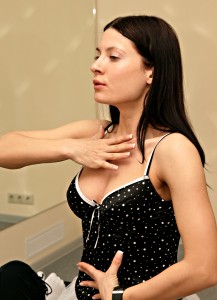Breathing: did you know it’s the Fountain of Youth?
 How is your breathing? Did you know good breathing may be a key to the Fountain of Youth?
How is your breathing? Did you know good breathing may be a key to the Fountain of Youth?
It doesn’t take particularly great psychic powers to guess that you might be sitting in a chair as you read this, and it’s likely that you’re slouching or perhaps leaning in over the desk.
And it’s also a good bet you’re breathing shallowly.
And all that is not so good for your health!
Sitting up straight and doing deep, slow breathing is one of the healthiest things you can do, yet few people do it!
In fact, most people need lessons in how to breathe correctly!
Children breathe fully and naturally until about the age of seven. That’s when they start to take on stress and awareness of what adults are doing and they lose their natural ability for healthy breathing.
So we have to re-learn what we came into this life doing so well.
Why do we have to learn breathing exercises? Well, we know that walking around the house or our office is not usually enough exercise for a healthy body – that’s why we jog, bike and go to the gym. In the same way, we need to do breathing exercises to promote a healthy respiratory system.
Andrew Weil, M.D., best-selling author and the Director of the Program of Integrative Medicine at the University of Arizona says, “If I had to limit my advice on healthier living to just one tip, it would be simply to learn how to breathe correctly.”
What does good breathing do for us?
- Increases energy
- Lowers blood pressure
- Improves circulation
- Beats anxiety disorders without drugs
- Helps the nervous system to function more smoothly
The latest research is that up to 90% of illness is stress-related. Breathing exercises are an excellent place to start bringing about relaxation.
Surprising facts about breathing
Breathing is the basis for all our cellular functions, our energetic well-being, and even our emotional health.
Each day the average person breathes about 20,000 times.
In fact, the human body is designed to release 70% of its toxins through breathing. So it’s important to get it right.
If you’re not breathing fully, you’re not ridding your body of all of its toxins, and other systems in the body must therefore work overtime to do so. This in itself can lead to illness.
We can survive weeks without food, days without water, and almost no time without breath. Yet most people use only a small part of their respiratory capacity.
In fact, the average person uses only 20% of their lung capacity.
Dr. Weil estimates that 80% of the population is breathing incorrectly and don’t know it!
The good news is that it’s easy to learn to breathe correctly.
I used to be a shallow breather, but I’ve been doing daily breathing exercises for many years, and today, when I stop to pay attention to my breathing, I’m pleased to find it is deep and slow.
How do YOU breath?
 Place your left hand on your abdomen and your right on your chest. As you inhale, which hand moves more?
Place your left hand on your abdomen and your right on your chest. As you inhale, which hand moves more?
If your left hand moves more, you are an abdominal breather – well done!
If your right hand moves more, you are a chest breather and really need to focus on learning correct abdominal breathing.
Chest breathing is shallow and rapid, resulting in less oxygen to the blood and poor delivery of nutrients to the tissues.
Abdominal breathing, also called diaphragmatic breathing, is the healthiest way to breathe, and, with practice, you can train your body to breathe that way most of the time.
You’re not actually breathing into your abdomen, but your abdomen will rise as a result of correct breathing.
Here’s some more motivation for correct breathing:
Over our lifetime, our respiratory capacity naturally decreases unless we are consciously working to maintain it. One reason that the elderly can so easily succumb to pneumonia is that their respiratory capacity has diminished.
Research has directly associated respiratory capacity with longevity. A 13-year long study in Australia demonstrated that respiratory capacity was a more significant factor than tobacco use, cholesterol levels and insulin metabolism in determining people’s longevity.
The 29-year Buffalo Health Study and the 30-year Framingham Heart Study also found a direct correlation between lung function and longevity.
Dr. Otto Warburg received the 1931 Nobel Prize for proving that cancer cells cannot survive in an oxygen-rich environment.
So that’s pretty good motivation for deep breathing right there.
In a nutshell, the better you breathe, the longer and better you live.
Are you a runner? You can train to use oxygen more efficiently. Check out this article from HVMN: VO2 Max: Training to Use Oxygen Efficiently.
The Key to Healthy Breathing:
- Deeper
- slower
- quieter
- more regular
If you’re very upset, for example you’re in a car that has been rear-ended, it’s likely your breathing will become shallow, rapid, noisy and irregular. Consciously change your breathing to: deeper, slower, quieter, more regular and you’ll calm down.
Here are key tips:
First, sit or lay down with the spine straight.
Inhale slowly, expanding your rib cage and allowing your abdomen to expand; don’t breathe shallowly from your chest.
Exhales should be longer than inhales. When your exhale is even a few counts longer than your inhale, the vagus nerve (running from the neck down through the diaphragm) sends a signal to your brain to turn up your parasympathetic nervous system [relaxation response] and turn down your sympathetic nervous system [stress response].
According to Lissa Rankin, M.D., the best selling author of Mind Over Medicine: Scientific Proof That You Can Heal Yourself the body’s natural self-repair mechanisms only work when the relaxation response is activated.
I believe that one reason people smoke is that it changes their breathing and relaxes them; they could most likely relax by changing their breathing and forget the cigarette.
A breathing technique from Dr. Weil
Breath Counting is a relaxing breathing technique from Dr. Weil:
Sit in a comfortable position with the spine straight and head inclined slightly forward. Gently close your eyes and take a few deep breaths. Then let the breath come naturally without trying to influence it.
- To begin the exercise, inhale, then count “one” to yourself as you exhale slowly and deeply.
- The next time you exhale, count “two,” and so on up to “five.”
- Then begin a new cycle, counting “one” on the next exhalation.
Never count higher than “five,” and count only when you exhale.
You will know your attention has wandered when you find yourself up to “eight,” “12,” even “19.”
Dr. Weil suggests doing 10 minutes of this form of meditation every day.
My book The Fountain of Youth Is Just a Breath Away; Breathing Exercises for Relaxation, Health and Vitality is a great place to start learning to breath correctly.
The breath – meditation connection
Meditation is another thing that brings deep relaxation. In fact, the benefits of meditation are numerous and I’ve written about it a previous post.
What is meditation? Meditation is simply paying attention to something other than our random thoughts.
According to the National Science Foundation, our brains produce up to 50,000 thoughts per day and 95% are the same as yesterday!
Anything that can help us focus on relaxation instead of 50,000 random thoughts is going to be helpful. If you don’t have a regular meditation practice, breathing exercises are a good beginning.
Give it a try and let me know in the comments section how it goes!
Molly Larkin is the co-author of the international best-seller “The Wind Is My Mother; The Life and Teachings of a Native American Shaman” and other books on health. She is passionate about helping people live life to their fullest potential through her classes, healing practice and blog at www.MollyLarkin.com

